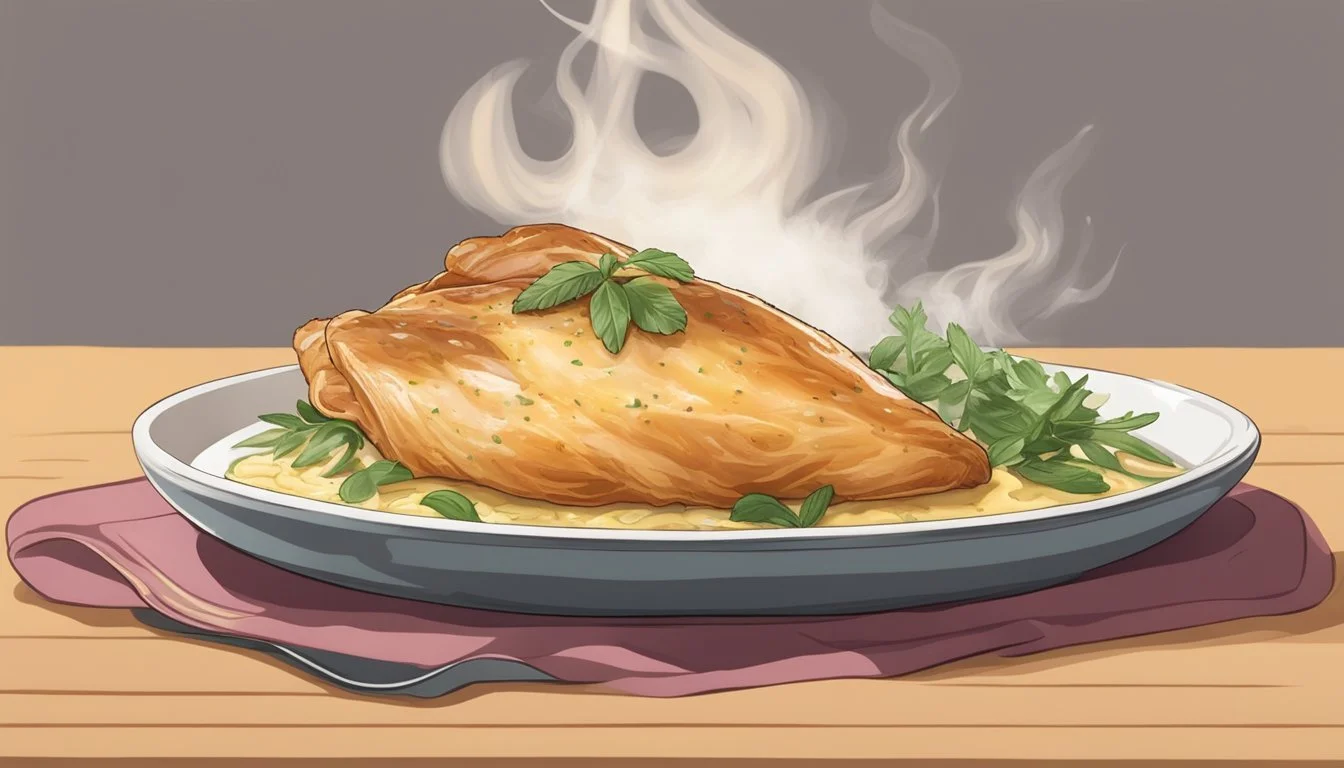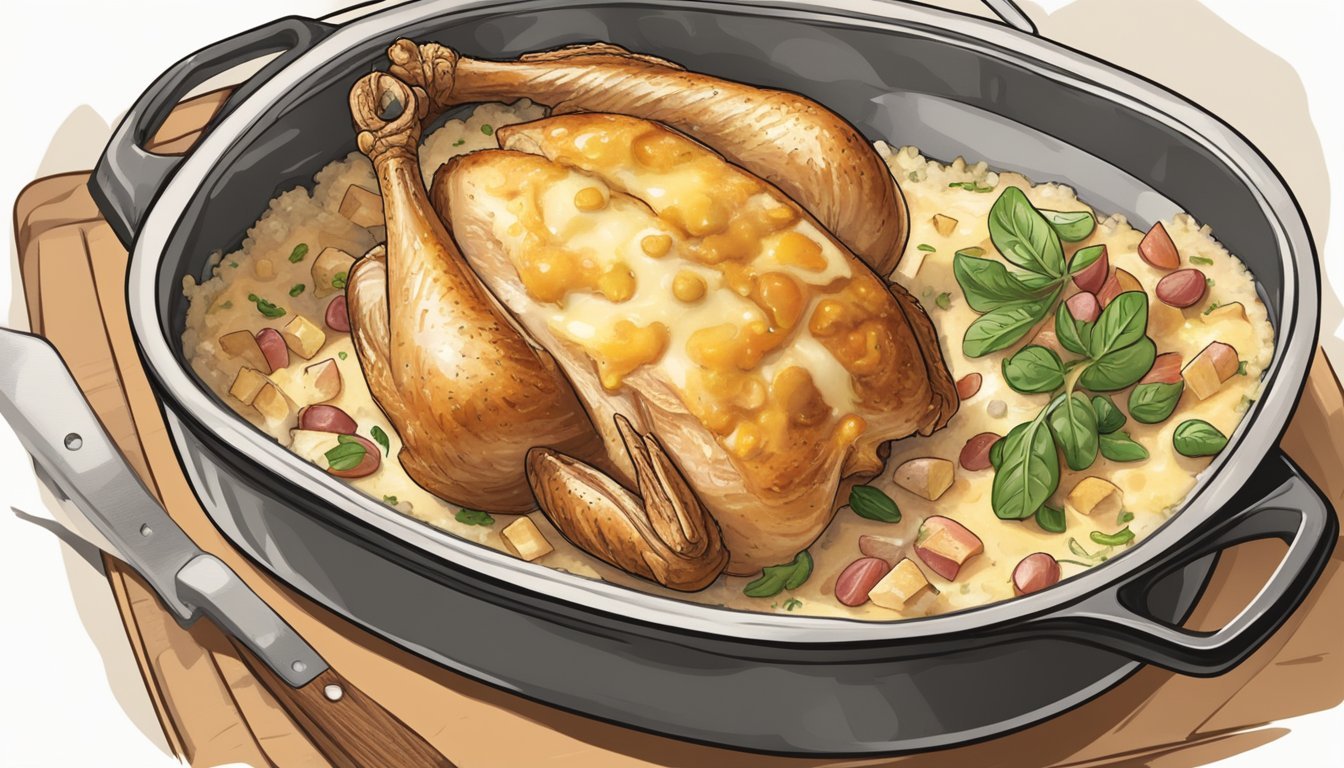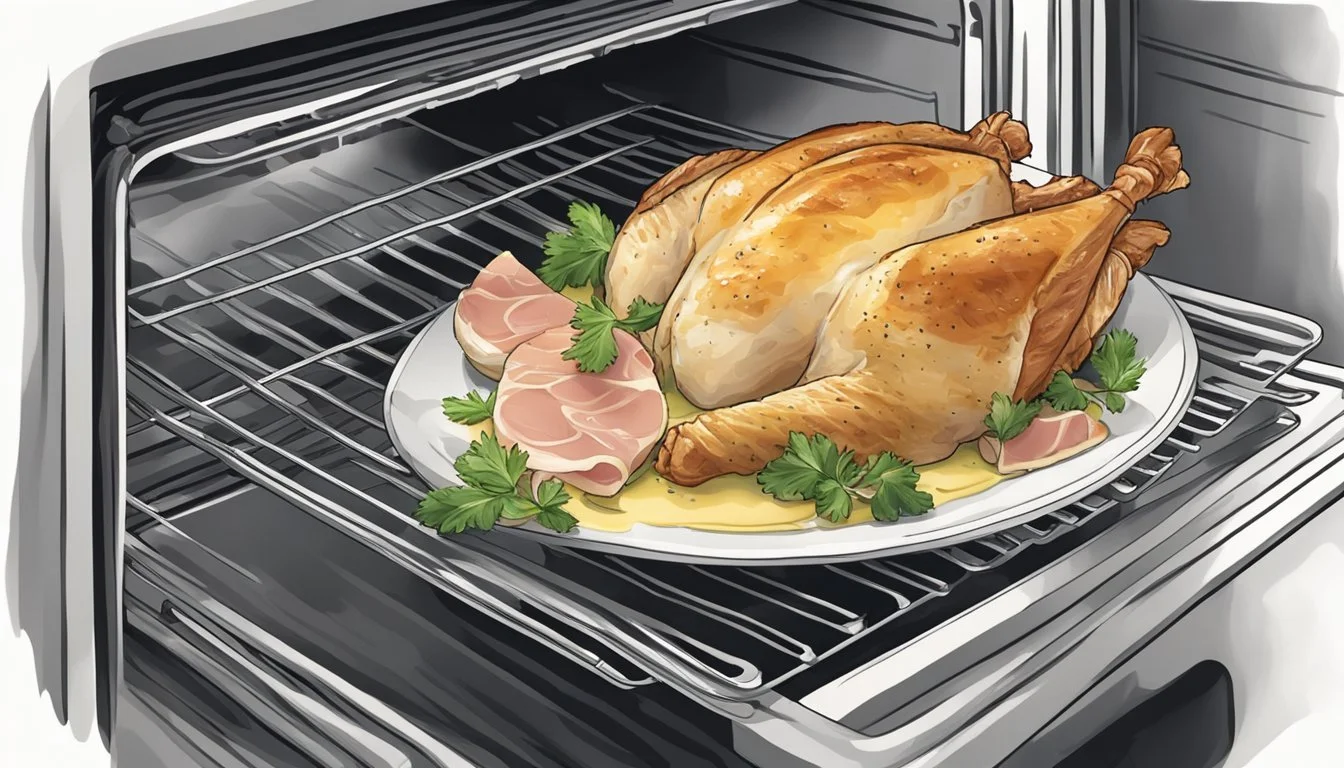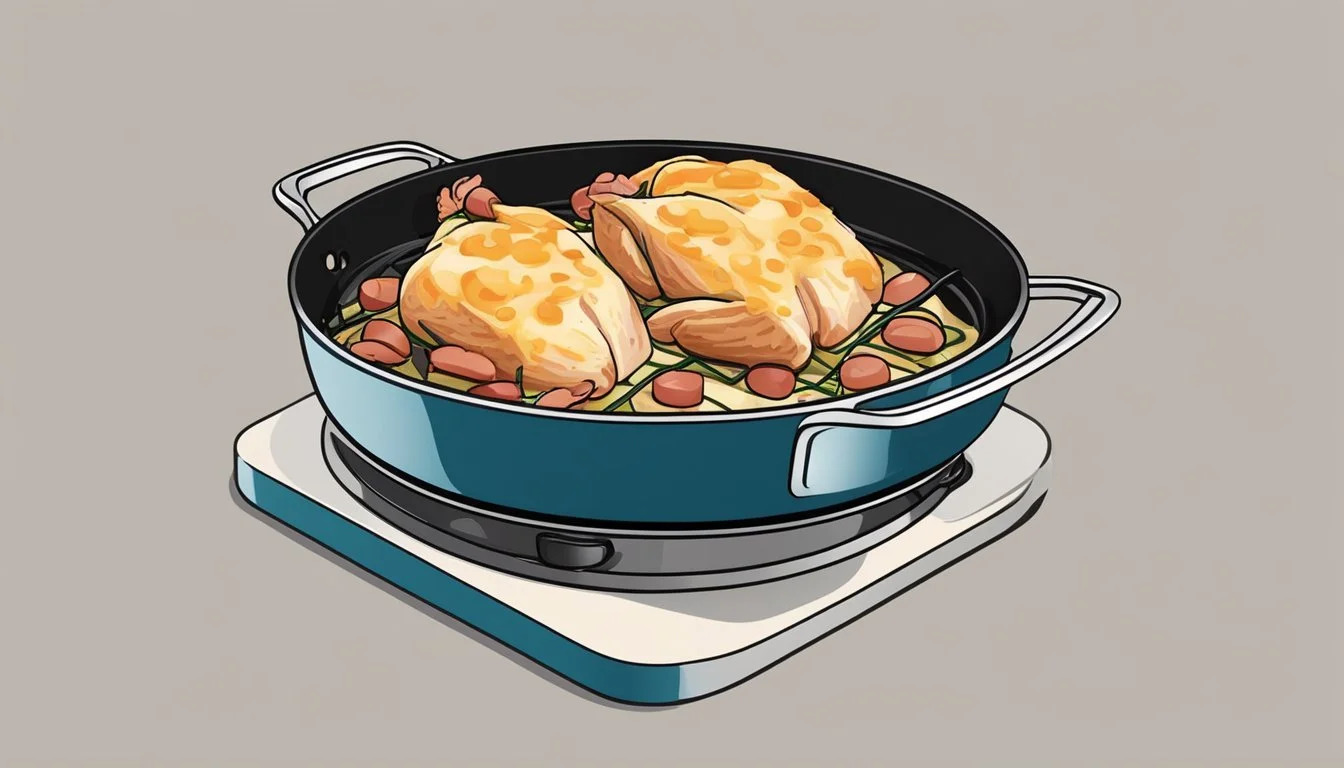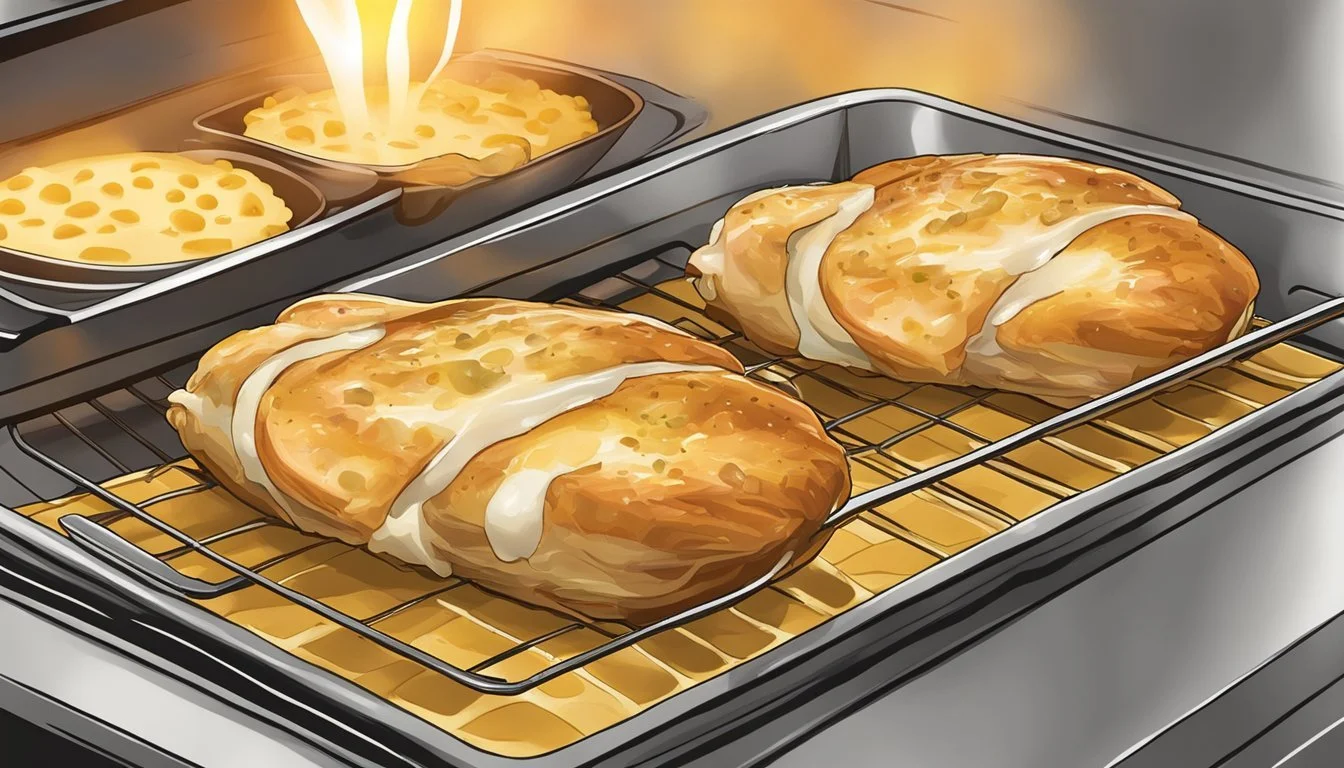Best Way to Reheat Fontina and Prosciutto Stuffed Chicken
Tips for a Moist and Cheesy Dish
Reheating a fontina and prosciutto-stuffed chicken breast perfectly is a culinary challenge that many face when looking to enjoy leftovers. With the rich, creamy characteristics of fontina cheese and the saltiness of prosciutto, preserving the moisture and flavor is paramount to recreating the fresh-out-of-the-oven taste. Since the chicken was initially cooked with care, ensuring it remains juicy and the cheese stays gooey upon reheating requires a delicate balance of temperature and technique.
There are several methods to warm up stuffed chicken, but some techniques stand above the rest in maintaining the dish's integrity. Moisture retention is key; hence, methods that provide a gentle and even reheating process are generally preferred. Utilizing these approaches not only keeps the chicken succulent but also prevents the careful arrangement of prosciutto and cheese from becoming compromised during warming.
The stuffed chicken breasts, enveloped in prosciutto, also need attention to detail to keep the wrap intact and flavorful. The seasoning that complements the meat and its filling must remain consistent, ensuring that every bite provides the harmony of flavors that the dish originally offered. The preferred reheating strategy will respect these elements, presenting a final product that is nearly indistinguishable from its first serving.
Essential Ingredients Overview
When reheating Fontina and Prosciutto Stuffed Chicken to keep it moist and cheesy, it's crucial to understand the key components and nutritional aspects of the dish. This comprehensive breakdown covers the essential ingredients and explores the protein profile of chicken.
Examining Key Ingredients
Chicken: As the core ingredient, chicken is versatile and provides a substantial amount of protein.
Protein: High-quality protein is essential for muscle repair and overall health.
Fat: Skin-on chicken adds more flavor and fat, but a skinless option offers less fat content.
Fontina Cheese: Known for its creamy texture and savory taste, Fontina contributes richness to the dish.
Calcium: Essential for bone health, Fontina is a good source of calcium.
Saturated Fat: While providing flavor, it also adds saturated fat which should be consumed in moderation.
Prosciutto: This dry-cured ham infuses the dish with a pleasant saltiness and depth.
Sodium: Prosciutto is high in sodium, adding to the flavor profile but also the sodium content of the meal.
Seasonings:
Salt: Enhances flavors and should be used to taste.
Pepper: Adds a mild spice element and aroma to the chicken.
Oil:
Used to cook the chicken, it helps to keep the dish moist. A high smoke point oil is preferred for its stability at high temperatures.
Benefits of Chicken as a Protein Source
Chicken is esteemed for its lean protein, helping to maintain and build muscle tissue. As a rich source of vitamins and minerals, including vitamin B6, niacin, and phosphorus, chicken not only serves as a pivotal ingredient in the dish but also delivers nutritional value. It's also a source of:
Potassium: Aids in muscle and nerve function.
Cholesterol: Present in chicken, it's wise to monitor intake for cardiovascular health.
Iron and Vitamin B12: Important for energy metabolism and the prevention of anemia.
In conclusion, each component in the Fontina and Prosciutto Stuffed Chicken has its unique attributes that contribute to the dish's texture, flavor, and nutritional profile, particularly focusing on the outstanding protein that chicken brings to the table.
Preparation Techniques
The key to a flavorful reheated stuffed chicken breast lies in the initial preparation. Correctly butterflyflying the meat, wrapping it with prosciutto, and stuffing it with fontina ensure that the chicken remains moist while the cheese melts perfectly.
Properly Butterflying Chicken Breasts
They start by placing the chicken breast flat on a cutting board. Using a sharp knife, one cuts horizontally into one side of the chicken breast, stopping before cutting all the way through. They can use a mallet or rolling pin to gently flatten the breast to an even thickness. This creates an ideal pocket for stuffing and helps in even cooking.
Wrapping with Prosciutto
To maintain moisture while adding flavor, a slice of prosciutto should be laid on the inside of the butterfly-cut chicken. They carefully wrap the seasoned chicken breast, ensuring the prosciutto covers it entirely. This helps seal in the juices during the cooking process.
Stuffing with Fontina
A generous portion of fontina cheese is placed in the center of the prepared chicken breast. The edges of the chicken breast are brought around the cheese, and the entire package is secured with toothpicks. This ensures the cheese remains inside the chicken as it melts. Preheating the oven or skillet before cooking is crucial for a moist result.
Pre-Reheat Preparation
Before reheating your stuffed chicken breasts, it is crucial to set up your kitchen for the best results. Preparation plays a significant role in retaining the dish's moisture and savory qualities. These steps will help maintain the juiciness of the chicken and the gooeyness of the Fontina cheese.
Setting Up for Reheating
To start, preheat the oven to 350°F (175°C) to ensure a timely and even reheating process. Select an oven-safe dish fit for the size of your stuffed chicken breasts to avoid overcrowding. Overcrowding can lead to uneven heating of the chicken. It's also key to have aluminum foil handy for later use to preserve moisture during reheating.
Preserving Moisture Pre-Reheat
Before the chicken goes into the oven, it's essential to address moisture retention. To achieve this:
Take the stuffed chicken out of the fridge and let it sit at room temperature for about 15-20 minutes. This step reduces the temperature shock when heating and can prevent drying out.
In the meantime, prepare a microwave-safe plate if opting for a quicker reheating method. Cover the chicken loosely with a microwave-safe cover or a damp paper towel, which will add moisture back to the chicken as it heats.
For those using an oven, after the chicken has rested:
Place the chicken in the oven-safe dish.
Add a small amount of water or chicken broth to the base of the dish to create a steamy environment as the chicken reheats.
Cover the dish with aluminum foil to keep the moisture enclosed with the chicken, preventing it from escaping. Avoid using plastic, waxed paper, or plastic wrap as these can melt at high temperatures and are not suitable for oven use.
Reheating Methods
When reheating fontina and prosciutto stuffed chicken, the goal is to maintain the dish's moist interior and crisp exterior. Choosing the right reheating method ensures the chicken does not dry out and the cheese remains gooey.
Oven Reheating for Best Results
Preheat the oven to 350°F (175°C).
Place the chicken in an oven-safe dish, and cover with foil to trap moisture.
Heat for 15-20 minutes, checking for an internal temperature of 165°F with a food thermometer ensures safety and doneness.
Microwave Reheating
Arrange the chicken on a microwave-safe plate and loosely cover with a damp paper towel to retain moisture.
Reheat at medium power for 2-4 minutes, rotate or stir halfway through if possible.
Check the internal temperature reaches 165°F before consumption.
Stovetop Warming Techniques
Heat a skillet with a small amount of butter or olive oil on medium heat.
Add the chicken to the skillet, turning frequently for even reheating.
Monitor for an even crispness on the outside while ensuring the inside reaches 165°F.
Utilizing the Air Fryer
Preheat the air fryer to 350°F (175°C).
Place the chicken in the air fryer basket, making sure not to overcrowd.
Cook for about 5-7 minutes, checking halfway to maintain crispiness.
Verify the internal temperature with a food thermometer to confirm it has reached 165°F.
Post-Reheat Tips
When reheating a fontina and prosciutto stuffed chicken breast, it's crucial to maintain the delicate balance of moisture and cheesiness while ensuring it’s safely heated to the proper temperature.
Retaining Moisture and Cheesiness
To keep the stuffed chicken breast moist and the cheese melty, one should let the chicken rest for a few minutes after reheating. Resting allows the juices to redistribute and the cheese to achieve a gooey consistency without the risk of a dry texture. To protect the chicken's moisture during reheating, cover it with a damp paper towel or aluminum foil, forming a tent to lock in steam.
Tip: After reheating, check the internal moisture with a fork. If juices run clear, it indicates a moist interior.
Cheese Check: Gently press the top of the chicken; if it has some give, the cheese inside is likely soft and warm.
Ensuring Safe Serving Temperatures
A food thermometer is an indispensable tool for verifying that the chicken has reached a safe internal temperature of 165°F (74°C) post-reheat. Insert the meat thermometer into the thickest part of the stuffed chicken, making sure it doesn't touch the cheese filling as this can give an inaccurate reading.
Temperature Guide:
Meat Area Temperature Thickest part 165°F (74°C) Near the filling Avoid
Safety Reminder: Always use a clean food thermometer to prevent cross-contamination.
Accompaniments and Pairings
Choosing the right side dishes and wine can elevate the experience of enjoying reheated fontina and prosciutto stuffed chicken. The aim is to complement the richness of the cheese and the savory notes of the prosciutto without overwhelming the palate.
Selecting Side Dishes
When pairing side dishes with a dish as rich and flavorful as fontina and prosciutto stuffed chicken, keeping balance in mind is key.
Pasta: A simple pasta garnished with rosemary can add an aromatic touch without overshadowing the main dish.
Green Beans: They offer a crisp, fresh counterpoint when lightly sautéed in olive oil and garlic.
Mashed Potatoes: Creamy mashed potatoes can be enhanced with a hint of roasted garlic to match the chicken's richness.
Crusty Bread: Bread serves as an excellent vehicle to soak up any escaping juices and maintains the meal's hearty feel.
Mushrooms: For a side with umami, sautéed mushrooms complement the savory notes of prosciutto and fontina perfectly.
Wine and Flavor Pairings
Selecting the right wine to accompany fontina and prosciutto stuffed chicken can enhance the flavors and add a level of sophistication to the meal.
White Wine: A crisp, dry white wine can cut through the richness of the fontina and provide a refreshing contrast.
Chardonnay: Full-bodied and oak-aged versions have the intensity to stand up to the rich chicken.
Sauvignon Blanc: Its acidity and green notes can cleanse the palate between bites.
Flavorful Pairings:
Arugula leaves can be included in a wine pairing, providing a peppery note that contrasts nicely with a floral white wine.
Rosemary, a common aromatic herb in Italian cuisine, is versatile in wine pairings, specifically with herbaceous whites.
The key to successful pairings is to aim for harmony on the plate, matching the intensity and flavor profiles of the food with the wine.
Preservation and Storage Tips
Proper storage is essential to maintain the quality of fontina and prosciutto stuffed chicken leftovers. By adhering to a few key practices, one can preserve the dishes' moisture and flavor, ensuring they reheat to a nearly fresh state.
Storing Leftovers
To store leftovers properly, one should place the stuffed chicken in an airtight container. Refrigeration is essential to keep the chicken safe and to retain the texture of the fontina cheese. They should note that:
Leftover chicken should be cooled to room temperature before storing.
The refrigerator temperature must be below 40°F to prevent bacterial growth.
Best Practices for Refrigeration:
Consume within 3 to 4 days for optimal taste.
Avoid direct contact with strong-smelling foods to prevent flavor transfer.
Freezing for Long-Term
Freezing stuffed chicken is a viable method to extend its shelf life while preserving its qualities. It's crucial to:
Wrap the chicken tightly with freezer-safe wrap or aluminum foil.
Label the wrapped chicken with the current date for proper inventory management.
Steps for Freezing:
Place the wrapped chicken in freezer bags to safeguard against freezer burn.
Record the freezing date on the bag.
When ready to reheat, one must thaw the chicken in the refrigerator overnight to ensure even reheating and maintain a moist texture. It's recommended to consume frozen chicken within 2 months for best quality.
Frequently Asked Questions
When reheating Fontina and Prosciutto Stuffed Chicken, maintaining the succulent cheese and ensuring the chicken does not dry out are the focal points to address. Here's how one can tackle common concerns about reheating this dish efficiently.
Addressing Common Concerns
Q: What is the recommended method to reheat stuffed chicken?
Reheat the chicken in a microwave. To prevent dryness, one should cover the chicken with a microwave-safe lid or a damp paper towel, reheating it at medium power for 2-4 minutes. This time may vary depending on the microwave's wattage.
Q: How can I ensure the cheese stays gooey after reheating?
To keep cheese moist and gooey, reheating should be done gently. If using an oven, one might consider adding a splash of chicken stock before reheating to add moisture and preserve the cheesy texture.
Q: Can I use broth instead of stock to keep the chicken moist?
Chicken broth can be a suitable alternative to stock. It's generally thinner and less concentrated, yet it still provides moisture and a savory flavor to the chicken during heating.
Q: Will broiling help in reheating stuffed chicken?
Broiling is not typically recommended for reheating stuffed chicken as it can cause the cheese to overmelt and potentially burn, and can also toughen the exterior of the chicken.
Q: What are some tips for incorporating additional moisture when reheating?
One might reintroduce moisture by drizzling a small amount of sauce or a light touch of olive oil over the chicken, which helps to lock in moisture during the reheating process.
Q: Is it possible to include other ingredients like ham or peas when reheating the chicken?
Adding ham or peas can complement the flavors of the stuffed chicken. Ensure to add these towards the end of the reheating process to preserve their texture and not to overcook them.

